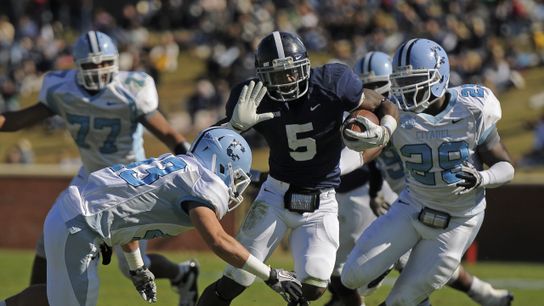Athletics departments build their budgets on the backs of revenue created from football, and that starts with the schedule. For athletics directors -- or whomever's job within the department it is to build the schedule -- that means creating a formula, a reliable pattern that will produce a reliable revenue level repeatable year after year.
At Georgia Southern, the formula is two "buy" games with Power 5 opponents, a "buy" game of their own with an FCS program, and a home-and-home with another FBS program. Combined with four Sun Belt home games annually, that creates a schedule with 11 home games every two years.
See for yourself below:
2015
at West Virginia
vs. Western Michigan
vs. The Citadel
at Georgia
2016
vs. Savannah State
at Western Michigan
at Georgia Tech
at Ole Miss
2017
at Auburn
vs. New Hampshire
at Indiana
at Massachusetts
2018
vs. Presbyterian
vs. Massachusetts
at Clemson
at Kent State
In an interview with Georgia Southern's athletics site, Eagles AD Tom Kleinlein explained how this year's schedule came about.
"The scheduling of games for the upcoming season actually began back in 2013 and, at that time, there were roughly 10 FBS teams who were looking for a game. Many teams are scheduled five to six years in advance. Schools schedule home games through the following ways: 1) Buy a game, which means we have to offer another team money to come to Statesboro to play; 2) Agree to play a team home and home; 3) Agree to play a team multiple times at their site in order to get a home game at our stadium," he said. "In 2013, none of the teams who were available agreed to play Georgia Southern in a home and home series. We as an institution were not in a position to offer upwards of $750,000 to $1 million to pay a team to come here. I also didn't feel it was appropriate to play teams multiple times at their home site for a reduced rate just to get one home game. That's devaluing our product and doing a disservice to our team and fans."
"After exploring these options, we still had the challenge of securing a fifth home game and one additional game in order to complete our schedule and meet both NCAA and conference mandates in terms of scheduling. We offered to play an FCS school and pay them $250,000 in order to get that fifth home game and we decided to take on another road game within the state of Georgia where many of our fans and alumni live. Overall, we ended up with a schedule playing seven times in the state of Georgia and we covered all of our financial needs."
Kleinlein also explained how he gets people to come to Statesboro without a giant pile of cash to offer them. "Statesboro is a great destination for people to come and play here. You can bring donors and take them to Hilton Head, Savannah, Sea Island and the surrounding areas. There's a lot to offer. Where it becomes a challenge for us, let's say we play a regional Power 5 team ... they're going to ask me for 5,000 or more tickets. That's a fifth of our stadium that I have to give up to them. Granted, we'll make revenue on those tickets, but we're cutting out a group of people who may want to see that game. Now, you want to create that kind of demand as an athletic director, so that's not a bad problem to have. Our stadium size is not a significant problem, it's convincing a Power 5 team to give up its home game revenue that's proving to be problematic," he said.
"We're also limited in the resources to pay people. The teams that we 'buy' are FCS schools we have the ability to pay. We don't have the ability to go buy a Group of 5 game right now. I can't say 'I'll pay you $750,000 to come play in Statesboro.' I can't do that. I have a fiscal responsibility to this department and university, so our financial ability to attract a team to come here is very limited."
Kleinlein said the model he patterns Georgia Southern's football rise on is that of Virginia Tech. "When they kicked off on Thursday nights, Enter Sandman was playing, the band was jumping up and down and fans were going crazy. What an unbelievable atmosphere. If you listen to anyone talk about Virginia Tech, they talk about a great atmosphere. Well, they did that on Thursday nights. They weren't always playing on Saturdays. People would drive in from hours away to Blacksburg to be a part of that experience. Blacksburg is very similar to Statesboro in size and location. It can be done, it just requires a willingness from fans and students to show up and provide a game day atmosphere that people desire because it's special and unique."
